A case study by Casey Sexton of North Georgia Hoof Care
In August of 2019 I was referred to a client by our local equine vet. The horse had a bad case of white line disease, and was chronically abscessing. The owner was looking into euthanization due to the horse’s consistent lameness. The previous farrier had done a large wall resection and put the horse in shoes. Unfortunately, the lameness persisted.
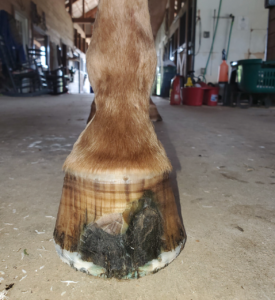
Wall resection showing white line disease on Right Front
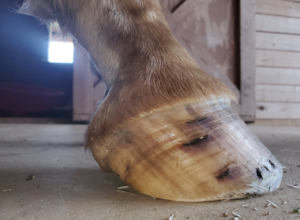
Chronic abscessing of lateral quarter of Right Front
We know that white line disease can only occur when there is already separation between the wall and sole present. Thus, a healthy and tight laminar and white line connection is not a conducive environment for white line disease. Knowing this, I first recommended a dietary change, because we often see laminae detachment in horses with diets that are high in non-structural carbohydrates (listed as NSC on the label) and/or unbalanced mineral intake. The owner switched from sweet feed to Timothy pellets, and from Farrier’s Formula to Vermont Blend supplement to eliminate the high amount of starch and sugar in the horse’s diet and add a balanced, high-quality supplement. This horse was also turned out on pasture 24/7, so I recommended a grazing muzzle to ward off some extra sugar intake. Please always consult your vet or nutritionist before making changes to your horse’s diet.
Next came the trim. Since the white line separation was occurring specifically at the toe, I made sure to reduce the amount of leverage that the toe was getting so it would not be inclined to continue mechanically separating. I achieved this by bringing the toe back to where the white line begins. This horse also had a deep central sulcus infection, shown in the image below. This is characterized by a “butt crack” appearance between the heels, at the back of the frog. Since one of my goals, as the farrier, is to have the horse land heel first, I knew that this needed to be dealt with. Often, we find that horses with central sulcus infections will avoid landing heel first, due to the deep, painful crevice located between their heels. The owner began daily treatment of that area. I recommended Artimud by Red Horse Products.
 After his trim and diet consultation, we opted to put the horse in EasyCare’s Easyboot Cloud therapy boots for 23/7 turn out. This ensures that he has at least one hour per day to have his boots off and let his hooves breathe while the boots are cleaned and dried. I really like Clouds because they’re very easy for owners to take off and on, they stay on well, and they include a comfortable, slightly wedged pad that allows the horse to easily mold their ideal pad shape by how they choose to put weight on each hoof. For horses in turn out, I like to recommend wrapping the hoof in a diaper before putting the Cloud on. This wicks moisture away from the hoof, and acts as a barrier between the hoof and boot, making rubs less likely.
After his trim and diet consultation, we opted to put the horse in EasyCare’s Easyboot Cloud therapy boots for 23/7 turn out. This ensures that he has at least one hour per day to have his boots off and let his hooves breathe while the boots are cleaned and dried. I really like Clouds because they’re very easy for owners to take off and on, they stay on well, and they include a comfortable, slightly wedged pad that allows the horse to easily mold their ideal pad shape by how they choose to put weight on each hoof. For horses in turn out, I like to recommend wrapping the hoof in a diaper before putting the Cloud on. This wicks moisture away from the hoof, and acts as a barrier between the hoof and boot, making rubs less likely.
After eight months of consistency, the white line disease grew out. The horse went back into work and we have been maintaining ever since! Here are pictures from what I deemed his “graduation day”- graduating from having any white line disease present on his hooves! These images were taken in April of 2020.
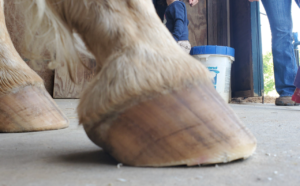
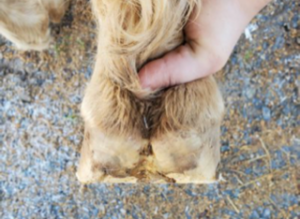
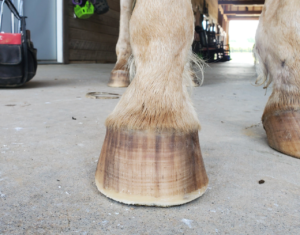
About the Author:
 Casey Sexton is the owner of North Georgia Hoof Care in Atlanta, Georgia. She was born into a family of farriers, with both her Mom and brother also being in the business. When she’s not working on rehab cases or maintenance horses, you’ll find her hanging out with her husband and two daughters. For more information, check out www.northgeorgiahoofcare.com.
Casey Sexton is the owner of North Georgia Hoof Care in Atlanta, Georgia. She was born into a family of farriers, with both her Mom and brother also being in the business. When she’s not working on rehab cases or maintenance horses, you’ll find her hanging out with her husband and two daughters. For more information, check out www.northgeorgiahoofcare.com.






Super interesting! I’m curious to know if the use of the Clouds was to make the horse more comfortable from a lameness standpoint or to keep out any additional bacteria/debris, or both?
In this case, I believe the Clouds were used to make the horse more comfortable.
Comments are closed.